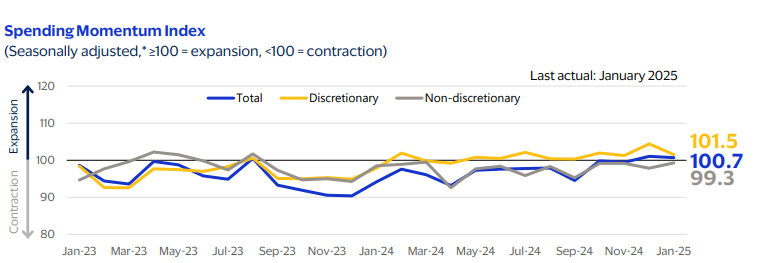Australian Consumer Spending Holds onto Gains, Starts 2025 in Expansion Territory

After a weak year overall for Australian consumer spending, Visa’s Australia Spending Momentum Index (SMI) remained in expansion territory at 100.7 in January. The reading’s relative consistency with the previous month, which included strong holiday sales, bodes well for a sustained recovery. Spending momentum improved in all states and territories except for the Australian Capital Territory. While Victoria and Queensland were the only two states with readings below 100, their first readings for 2025 were above their 2024 averages and are on track to hit the 100 mark.
Following the holiday shopping season, the discretionary SMI fell 2.9 points to a still-solid 101.5 in January. The index stayed above 100 for the ninth consecutive month, indicating strength in spending momentum on non-essentials, such as travel. The index for all states and territories remained at healthy levels, with Queensland having the strongest reading. At the same time, restaurant spending momentum saw a decline, led by the Northern Territory and South Australia. By contrast, the non-discretionary index inched up 1.4 points to 99.3, with the strongest improvement in two states that experienced weak consumer spending in 2024: Tasmania and South Australia.
With inflation slowing, consumer spending is expected to be resilient, with geopolitics and the pace of interest rate cuts two major risk factors to watch.

Spending Momentum Index
(Seasonally adjusted,* ≥100 = expansion, <100 = contraction), last actual: January 2025
*The discretionary and non-discretionary categories exclude restaurant and gas spending; both restaurant and gas are included in the total SMI. See additional definitions of spending categories on page 3 of the attached report.
Source: Visa Business and Economic Insights. The Visa Australia SMI measures the current month relative to the same month last year. The national readings of the index are based on year-over-year changes in consumer spending with Visa bankcards.

